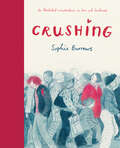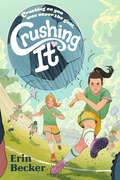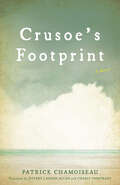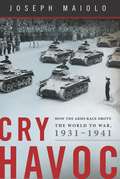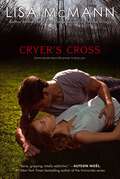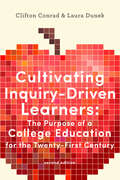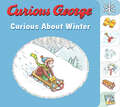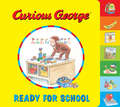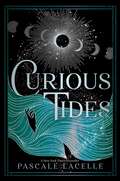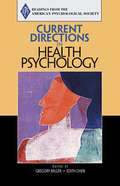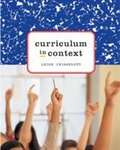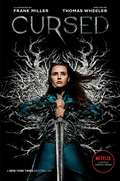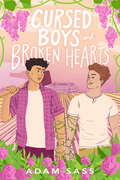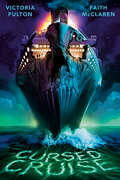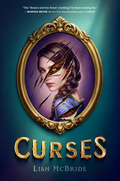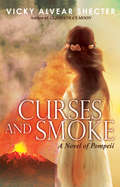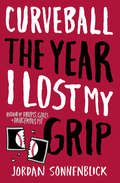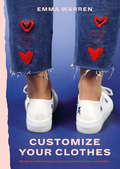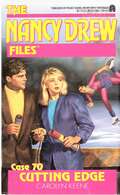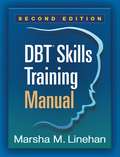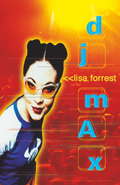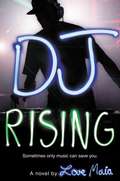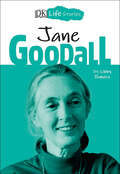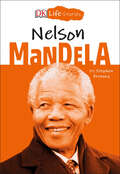- Table View
- List View
Crushing
by Sophie BurrowsLife is full of connections – if you know how to make them. Crushing follows two people -- one determined and a bit awkward, the other unsure where to begin -- longing to find out where they belong. Their intersecting and overlapping journeys reveal hidden connections and the unpredictable and unexpected ways we may find each other. Achingly beautiful, quietly defiant, and full of subtle wit and wisdom, Crushing is a story told in silence; a story without words but bursting with life and color. This stunning debut graphic novel from Sophie Burrows is a timely look at life in an age of distance and a story of love and understanding -- a perfect book to read and to share.
Crushing It
by Erin BeckerFrom debut author Erin Becker comes an action-packed but tender novel about first romance, queer identity, and learning how to be brave when it matters the most.On the soccer field, Magic Mel is in her element. She&’s ready to lead her team to victory at the city championship in her new role as captain. Off the field, however, is a totally different story. Mel can&’t get a handle on her class presentation, her friend group has completely dissolved, and her ex-friend-current-teammate, Tory, is being the worst. The only place she feels like herself is in her text conversations where she shares her secret poetry with BTtoYouPlease.Tory McNally, on the other hand, is keeping everything together, thank you very much. So what if her mom is more preoccupied with her craft projects and new husband than her, or that she&’s down to one IRL friend because of annoying, overly peppy &“Magic&” Mel? She&’s perfectly fine, and even when she maybe isn&’t, she&’s got NotEmilyD to text with.As the championships loom closer, everything around Mel and Tory starts to get more and more complicated: the dynamics on the field, the rift between their friend group, and, as they connect anonymously online, maybe even their feelings for each other . . .
Crusoe’s Footprint (CARAF Books)
by Patrick ChamoiseauThe discovery in Robinson Crusoe of the footprint of a fellow human on an abandoned island is a haunting and iconic moment in world literature. In the hands of Patrick Chamoiseau, one of the most innovative and lauded authors in the French language, this moment of shattered solitude becomes an occasion for Crusoe to reconsider his origins, existence, and humanity and for one of our most acclaimed novelists to craft a powerful meditation on race and history.Chamoiseau’s novel contrasts two intertwining narratives—the log entries of a slave ship’s captain and the story of a castaway who awakens on a beach and must rebuild his entire world alone. Chamoiseau creates a new perspective on the Crusoe myth, not only injecting the slave trade and Creole history into this previously ahistorical tale but conceiving an intensely original, freeform prose influenced by Creole cadence. This powerful work by a literary master is available in English for the first time in this eloquent and vivid translation.
Cry Havoc: How the Arms Race Drove the World to War, 1931-1941
by Joe MaioloDid the arms race of the 1930s cause the Second World War? In Cry Havoc, historian Joseph Maiolo shows, in rich and fascinating detail, how the deadly game of the arms race was played out in the decade prior to the outbreak of the Second World War. In this exhaustively researched account, he explores how nations reacted to the moves of their rivals, revealing the thinking of those making the key decisions--Hitler, Mussolini, Chamberlain, Stalin, Roosevelt--and the dilemmas of democratic leaders who seemed to be faced with a choice between defending their nations and preserving their democratic way of life. An unparalleled account of an era of extreme political tension, Cry Havoc shows how the interwar arms race shaped the outcome of World War II before the shooting even began.
Cryer's Cross
by Lisa McMannKendall loves her life in small town Cryer's Cross, Montana, but she also longs for something more. She knows the chances of going to school in New York are small, but she's not the type to give up easily. Even though it will mean leaving Nico, the world's sweetest boyfriend, behind. But when Cryer's Cross is rocked by unspeakable tragedy, Kendall shoves her dreams aside and focuses on just one goal: help find her missing friends. Even if it means spending time with the one boy she shouldn't get close to... the one boy who makes her question everything she feels for Nico. Determined to help and to stay true to the boy she's always loved, Kendall keeps up the search--and stumbles upon some frightening local history. She knows she can't stop digging, but Kendall is about to find out just how far the townspeople will go to keep their secrets buried.... “Cryer’s Cross is an eerie, gripping, totally addictive, breathtaking whirl of a book with an ending that left me haunted for days. Lisa McMann has done it again—this book is unputdownable!” --Alyson Noël, #1 New York Times bestselling author of the Immortals series. "A brilliant, engaging, scary piece of fiction. Every word had me sliding closer to the edge of my seat and gripping the cover tighter and tighter. There are books in the world that make you question your reality and the things that go bump in the night--this is one of them." --Heather Brewer, New York Times bestselling author of the Chronicles of Vladmir Tod series
Cultivating Inquiry-Driven Learners: The Purpose of a College Education for the Twenty-First Century
by Clifton Conrad Laura DunekHow can colleges develop learners who pursue innovative ideas that enable them to flourish and contribute in a rapidly changing world?Two decades into the twenty-first century, our nation's colleges and universities no longer embrace a clear and convincing definition of the purpose of a college education. Instead, most institutions have fallen prey to a default purpose in which college is essentially workforce preparation for jobs that already exist, while students are viewed as commodities instead of being educated to flourish throughout their lives. But rather than bemoan the diminishing legacy of liberal education, this new edition of Cultivating Inquiry-Driven Learners argues that the time has come to advance a pioneering purpose of college that guides the undergraduate experience from program requirements to teaching and learning.This purpose, Clifton Conrad and Laura Dunek write, is anchored in the premise that the world in which we live is one in which change—environmental, cultural, economic, political—is a constant driving force. The authors envision a college-educated person in the twenty-first century as an "inquiry-driven learner": a person equipped with the capabilities to explore and cultivate ideas that will prepare them to successfully navigate constant change, capitalize on career opportunities, enrich their personal life, and contribute to the public good. They describe four signature capabilities that students must develop in order to innovate and adapt: core qualities of mind, critical thinking skills, expertise in divergent modes of inquiry, and the capacity to express and communicate ideas.Guided by this trailblazing vision, Conrad and Dunek have thoroughly revised every chapter of the book to reflect current scholarship and emerging trends. In an expanded conclusion, they provide a cornucopia of ideas for replenishing undergraduate education accompanied by real-world examples of innovative programs and practices from colleges and universities across the United States. Throughout, Cultivating Inquiry-Driven Learners challenges stakeholders from across higher learning—faculty, students, staff, administrators, and policymakers—to reflect on the purpose of college, embrace innovation, and ensure that students are educated to thrive in and contribute to our constantly changing world.
Curious George Curious About Winter (Curious George)
by H.A. ReySpend a snowy day with George in this picture book for preschoolers! Preschoolers will delight in exploring a typical winter day in this ebook featuring everyone's favorite monkey, Curious George. From shoveling to snow angels, coats to cocoa, little ones will enjoy a perfect day of winter play with Curious George in this ebook! Join George and the man with the yellow hat as they watch the first snowflakes fall, go sledding, and warm up by the fire in this book that incorporates age-appropriate concepts like counting, colors, and seek-and-find.
Curious George Ready for School: Ready for School (Curious George)
by H.A. ReyWhat is it like to go to school? George is about to find out… George is so excited to go visit his friend Rami&’s school! George packs a banana snack and is ready to have an adventure. And what an adventure school is! Between Circle Time, outdoor play, and the many toys and crafts, George is one happy monkey. But can a curious monkey make it through the whole day without getting into any trouble? Young kindergarteners and preschoolers-to-be will get a sense of what a day at school is like, helping them, too, feel ready for school.
Curious Tides (The Drowned Gods Trilogy)
by Pascale LacelleTwo starred reviews! &“A marvel in atmosphere.&” —Chloe Gong, #1 New York Times bestselling author of These Violent Delights Ninth House meets A Deadly Education in this gorgeous dark academia fantasy &“that will capture readers like a rip current&” (Publishers Weekly, starred review) following a teen mage who must unravel the truth behind the secret society that may have been involved in her classmates&’ deaths.Emory might be a student at the prestigious Aldryn College for Lunar Magics, but her healing abilities have always been mediocre at best—until a treacherous night in the Dovermere sea caves leaves a group of her classmates dead and her as the only survivor. Now Emory is plagued by strange, impossible powers that no healer should possess. Powers that would ruin her life if the wrong person were to discover them. To gain control of these new abilities, Emory enlists the help of the school&’s most reclusive student, Baz—a boy already well-versed in the deadly nature of darker magic, whose sister happened to be one of the drowned students and Emory&’s best friend. Determined to find the truth behind the drownings and the cult-like secret society she&’s convinced her classmates were involved in, Emory is faced with even more questions when the supposedly drowned students start washing ashore—alive—only for them each immediately to die horrible, magical deaths. And Emory is not the only one seeking answers. When her new magic captures the society&’s attention, she finds herself drawn into their world of privilege and power, all while wondering if the truth she&’s searching for might lead her right back to Dovermere…to face the fate she was never meant to escape.
Current Directions in Health Psychology
by Edith Chen Gregory MillerThese timely, cutting-edge articles allow instructors to bring their students real-world perspective--from a reliable source--about today's most current and pressing issues in health psychology.
Curriculum in Context: Designing Curriculum and Instruction for Teaching and Learning in Context
by Leigh ChiarelottEasily design appropriate curricula with CURRICULUM IN CONTEXT! This guidebook for teachers and curricula designers focuses on designing curriculum and instruction in the context of contextual teaching and learning, a system that enables students to find meaning by connecting the content of the lesson with the context of their lives. With a practical focus and numerous examples of designs created by actual teachers, this education text provides you with the concepts and skills you need to make appropriate curricular and instructional decisions for your own school and classroom.
Cursed (An Arthurian Retelling)
by Thomas WheelerNow an original series starring Katherine Langford on Netflix! The Lady of the Lake is the true hero in this cinematic twist on the tale of King Arthur created by Thomas Wheeler and legendary artist, producer, and director Frank Miller (300, Batman: The Dark Knight Returns, Sin City). Featuring 8 full-color and 30 black-and-white pieces of original artwork by Frank Miller.Whosoever wields the Sword of Power shall be the one true King. But what if the Sword has chosen a Queen? Nimue grew up an outcast. Her connection to dark magic made her something to be feared in her Druid village, and that made her desperate to leave… That is, until her entire village is slaughtered by Red Paladins, and Nimue&’s fate is forever altered. Charged by her dying mother to reunite an ancient sword with a legendary sorcerer, Nimue is now her people&’s only hope. Her mission leaves little room for revenge, but the growing power within her can think of little else. Nimue teams up with a charming mercenary named Arthur and refugee Fey Folk from across England. She wields a sword meant for the one true king, battling paladins and the armies of a corrupt king. She struggles to unite her people, avenge her family, and discover the truth about her destiny. But perhaps the one thing that can change Destiny itself is found at the edge of a blade.
Cursed Boys and Broken Hearts
by Adam SassA swoony contemporary romance from Adam Sass following a boy who is cursed to doom any romantic relationship—and the summer that changes everything.Grant Rossi is never getting a happily-ever-after.Ever since he was a kid and made a wish on his family&’s iconic Wishing Rose, his romantic relationships have been cursed to end. Following his most recent (and extremely public) dumping, Grant is languishing in a hot Chicago summer, abandoning his beloved design projects to sink back into depression. But when his family suggests spending the summer helping his aunt and uncle refurbish their beautiful but rundown B&B and vineyard—the home of the Wishing Rose that changed everything for him—Grant decides to accept. Maybe he can finally find a way to recover his creative spark...and break his curse. But things at the vineyard are not what Grant expects. The place is in almost total disrepair, and—even worse—the person his relatives hired to help is his former childhood crush, Ben—the first boy who broke his heart. As their chemistry sparks and the summer heats up, the wedge between them can&’t be ignored. But while they race to restore the B&B in time for the beloved local rose festival, grumpy but lovable Ben starts to break through Grant&’s carefully crafted defenses. Can Grant find a way to overcome his curse and open his heart, even when it&’s broken?
Cursed Cruise: A Horror Hotel Novel
by Victoria Fulton Faith McClarenFrom the authors of Horror Hotel, called "fast-paced and freaky" by #1 NYT bestselling author Kendare Blake, comes another addictive YA horror about a group of teen ghost hunters who are invited to travel onboard a haunted historic cruise ship.All aboard...After their fateful stay at the Hearst Hotel, the Ghost Gang is back with more spooks and more subscribers. They&’ve been invited to record onboard the RMS Queen Anne, a transatlantic luxury ocean liner with a colorful past of violent deaths of hundreds of passengers—souls that bought a one-way ticket to the afterlife (and never disembarked).When Chrissy, Chase, Kiki, and Emma board the ship, they have a funny feeling they&’ve been sucked into a ghostly time warp—a theory that takes a frightening turn when Chrissy goes missing on the first night.Unbeknownst to the rest of the group, Chrissy has been sucked into another time by a passenger who wants the Ghost Gang to know her untimely death was not an accident and the perpetrator is still alive—and on board this ship.
Curses
by Lish McBride"Curses is the 'Beauty and the Beast' retelling I've been waiting for." --Marissa Meyer, #1 New York Times bestselling author"A unique and twisty magical romp!" --Tamora Pierce, New York Times bestselling authorMerit Cravan refused to fulfill her obligation to marry a prince, leading to a fairy godling's curse. She will be forced to live as a beast forever, unless she agrees to marry a man of her mother's choosing before her eighteenth birthday.Tevin Dumont has always been a pawn in his family's cons. The prettiest boy in a big family, his job is to tempt naïve rich girls to abandon their engagements, unless their parents agree to pay him off. But after his mother runs afoul of the beast, she decides to trade Tevin for her own freedom. Now, Tevin and Merit have agreed that he can pay off his mother's debt by using his con-artist skills to help Merit find the best match . . . but what if the best match is Tevin himself?
Curses and Smoke: A Novel of Pompeii
by Vicky Alvear ShecterWhen your world blows apart, what will you hold onto?TAG is a medical slave, doomed to spend his life healing his master's injured gladiators. But his warrior's heart yearns to fight in the gladiator ring himself and earn enough money to win his freedom.LUCIA is the daughter of Tag's owner, doomed by her father's greed to marry a much older Roman man. But she loves studying the natural world around her home in Pompeii, and lately she's been noticing some odd occurrences in the landscape: small lakes disappearing; a sulfurous smell in the air. . . . When the two childhood friends reconnect, each with their own longings, they fall passionately in love. But as they plot their escape from the city, a patrician fighter reveals his own plans for them -- to Lucia's father, who imprisons Tag as punishment. Then an earthquake shakes Pompeii, in the first sign of the chaos to come. Will they be able to find each other again before the volcano destroys their whole world?
Curveball: The Year I Lost My Grip (Playaway Children Ser.)
by Jordan SonnenblickSometimes life's greatest accomplishments take place off the field.There's nothing All Star pitcher Peter Friedman loves more than baseball. He breathes it, dreams it, and works his tail off to be great. Most kids are nervous about starting high school, but when you're the star athlete, girls, popularity, and all-around stud status are sure to follow.Then a pitching accident over the summer ruins Pete's arm. If he can't play baseball in high school, what is he supposed to do? If he isn't the star pitcher, then who is he? To make matters more complicated, there's something going on with Pete's grampa -- he's acting weird and keeps forgetting important things.The only person Pete can confide in is Angelika, the amazingly cute girl in his photography class who might like Pete as much as he likes her . . . Only, Angie doesn't know if she can date someone who can't be honest with himself, or with the people he's closest to.
Customize Your Clothes: 20 hand embroidery projects to update your wardrobe
by Emma WarrenEmbroidering your own clothes with the exact design you'd like adds a fun hint of personality to your wardrobe - try stitching dogs, flowers, slogans or patterns on to any garment.Using a range of stitches, techniques, materials and designs, Customize Your Clothes guides you through which tools to use, which stitches work best with certain designs, and also teaches you how to embellish with a range of materials to add a special personal statement to your items that costs next to nothing.Projects such as a plant T-shirt, a monogrammed sweater and a fun star hat make up this collection of ideas and inspiration for personalising your wardrobe. Even learn to decorate an old sweater with pom poms and cut shapes out of a pair of jeans you've had lurking in the back of your cupboard - the possibilities are endless, you just need some thread, a needle and a bit of inspiration! By customising your clothes you will have your own unique collection of items all embroidered to your taste, colour, style and design - hand-stitched by you.
Cut and Run
by Ridley PearsonA spellbinding thriller pitting a U.S. federal marshal against the mob's most resourceful killer in a race to save the woman he loves, Six years ago, witness protection marshal Roland Larson did the unthinkable: He fell in love with a protected witness, Hope Stevens, whose testimony was to put away prominent members of the Romero crime family. When Hope's plan to "cut and run" is interrupted by both the government and the mob, she disappears into a new identity, taking with her not only her testimony but also a secret never shared with Larson. Larson, who has been looking for her ever since, is put back on her trail when the Romeros intercept the master WITSEC list from the Justice Department and Hope is believed to be among the first protected witnesses targeted for execution. In a series of terrifying encounters, Larson matches wits with a brutally ingenious killer whose sole target is Hope Stevens. For Larson, the stakes couldn't be higher--he must find Hope in order to protect her and simultaneously prevent the mob from auctioning off the master witness protection list--an act that will put seven thousand innocent, and not-so-innocent, lives in jeopardy.
Cutting Edge (Nancy Drew Files #70)
by Carolyn KeeneWhen a top female skater takes a terrible fall, Nancy suspects sabotage. In this slippery world of fierce competition, ambition, and industrial espionage, is Nancy headed for a dance with danger?
DBT® Skills Training Manual
by Marsha M. LinehanFrom Marsha M. Linehan--the developer of dialectical behavior therapy (DBT)--this comprehensive resource provides vital tools for implementing DBT skills training. The reproducible teaching notes, handouts, and worksheets used for over two decades by hundreds of thousands of practitioners have been significantly revised and expanded to reflect important research and clinical advances. The book gives complete instructions for orienting clients to DBT, plus teaching notes for the full range of mindfulness, interpersonal effectiveness, emotion regulation, and distress tolerance skills. Handouts and worksheets are not included in the book; purchasers get access to a Web page where they can download and print all the handouts and worksheets discussed, as well as the teaching notes.
DJ Max
by Lisa ForrestMaxine Phillips thinks she's got it all worked out. She's found the future in the hard, fast, relentless bass lines that drive her forward and keep her safe from the past: the mother she's never known, her beloved grandmother who died just a few years ago, and her grandfather Reg, so trapped in his grief that he scarcely notices Max anymore. Not that it bothers Max. Reg would never understand her new life, her dreams, her new job as a DJ. Once she and Reg were inseparable but now, ironically, they have been driven apart by their love of music. And by the past, of course, rising up and filling the space inside the beat, bursting Max's insides wide open with all the memories - and what's the point of that? Maxine Phillips is about to find out.
DJ Rising
by Love MaiaThe first thing I hear is music. The first thing I've always heard is music.Meet Marley, an unassuming high school junior who breathes in music like oxygen. In between caring for his heroin-addicted mother, and keeping his scholarship at a fancy prep school, he dreams of becoming a professional DJ.When chance lands Marley his first real DJ job, his career as "DJ Ice" suddenly skyrockets. But when heart-rending disaster at home brings Marley crashing back down to earth, he is torn between obligation and following his dreams.
DK Life Stories: Jane Goodall (DK Life Stories)
by Libby RomeroIn this kids' biography, discover the inspiring story of Jane Goodall, whose work with chimpanzees changed the way we understand animals and ourselves. Jane Goodall was a pioneer of primatology through her groundbreaking with chimpanzees in Africa. When she embarked on her career, women were discouraged from conducting scientific research, especially when that work meant living side by side with wild animals. Jane was a self-taught scientist, who bravely ventured out into the bush of Tanzania to discover the secret world of chimpanzees. Through perseverance and perceptive observation, she gained access to these elusive creatures and discovered that they are not so different from us. This new biography series from DK goes beyond the basic facts to tell the true life stories of history's most interesting people. Full-color photographs and hand-drawn illustrations complement thoughtfully written, age-appropriate text to create an engaging book children will enjoy reading. Definition boxes, information sidebars, maps, inspiring quotes, and other nonfiction text features add depth, and a handy reference section at the back makes this the one biography series every teacher and librarian will want to collect. Each book also includes an author's introduction letter, a glossary, and an index.
DK Life Stories: Nelson Mandela (DK Life Stories)
by Stephen KrenskyIn this kids biography, discover the inspiring story of Nelson Mandela, who became the first black president of South Africa after spending 27 years in prison.In 1964, Nelson Mandela was sentenced to a lifetime in jail. His crime? Attempting to overthrow a government that openly discriminated against its black citizens. After spending 27 years behind bars, Mandela was released, allowing him to continue his struggle for equality in South Africa--and to become the country's first black president. In this biography book for kids ages 8-11, learn all about Mandela's incredible life, his fight against apartheid, and how he helped bring peace to his nation.This new biography series from DK goes beyond the basic facts to tell the true life stories of history's most interesting people. Full-color photographs and hand-drawn illustrations complement thoughtfully written, age-appropriate text to create an engaging book children will enjoy reading. Definition boxes, information sidebars, maps, inspiring quotes, and other nonfiction text features add depth, and a handy reference section at the back makes this the one biography series every teacher and librarian will want to collect. Each book also includes an author's introduction letter, a glossary, and an index.
